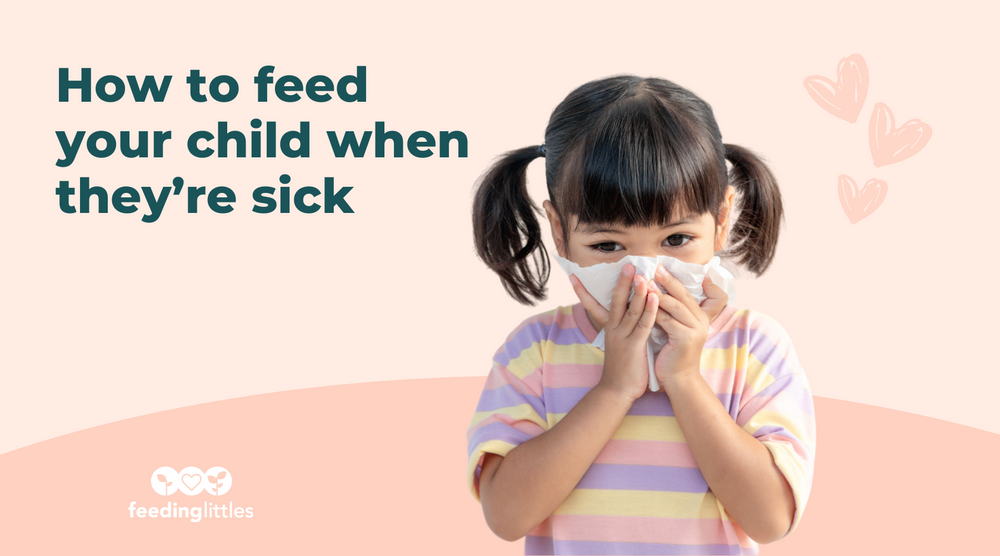
Note: This information does not replace medical advice. Work with your provider if you’re worried about how your child eats or drinks when ill. Additionally, these tips are meant to address acute illness, not chronic illness.
Have you noticed that kids get sick, like, a lot? This can be especially true for kids when they start daycare, preschool or elementary school, or when they start interacting with other children outside of their home.
As disruptive as illness can be for work, school, and your family’s plans, it can also impact how your child eats. How can we feed kids who are sick? We asked pediatrician Dr. Alok Patel, MD to help us compile some tips on how to feed our kids during respiratory illness or GI bugs, plus how to help awaken their taste buds and the role of vitamin C in illness. At the end you'll find tips for helping kids take medicine and bringing food to friends dealing with illness.
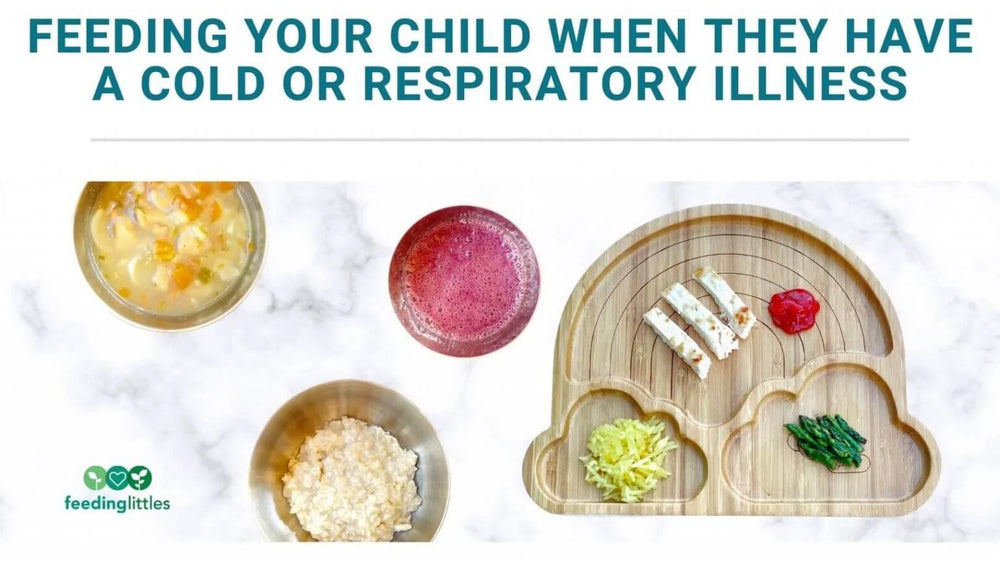
Respiratory Illness
When your child has a cold or respiratory illness, it may affect their appetite and drive to eat. Between coughing, fatigue, a runny rose and sore throat, they might not want to eat or drink like they usually do. They might be tired or uncomfortable, or maybe they’re unable to smell or taste food appropriately. Strep throat and Hand, Foot and Mouth Disease, while not respiratory illnesses, can have similar affects.
Physicians worry most about dehydration during illness – more on that below. While a child might not eat as much as usual, as long as they’re drinking a lot of fluid they should be OK in the short-term.
Babies: For babies under 12 months, getting enough milk to stay hydrated is most important during illness. Babies will likely prefer sticking to breastmilk or formula, and that’s OK. If your baby has really bad congestion, the use of a bulb suction or Nose Frida to clear up the congestion might make eating and drinking easier. Focus on regular breastfeeds or bottle feeds and watch for wet diapers (5-6 per day). If your baby is eating solids (6+ months), offer solid meals like usual but don’t be surprised if your baby isn’t interested. Stay consistent and continue to include your baby in family meals, as long as they’re not upset when they sit in their high chair.
Toddlers and Kids: For kids 12+ months, try to keep offering the same foods you always offer. Focus on lots of veggies, fruits, protein foods, whole grains and fats. Nutrition is important during illness, but their appetite and food preferences almost definitely change. You may find your child gravitating toward certain foods or surviving on familiar beige foods like crackers and bagels – this is OK. You might want to just feed them whatever sounds good for awhile until they feel better. As best you can, try to offer some variety in the food groups you serve, too. They might surprise you when they are suddenly interested in something again.
Sometimes it helps to integrate warm foods into their diet, like soup, broth, or oatmeal. These foods can help if they’re congested, feverish or have a sore throat. You can also help soothe a sore throat with cold and smooth foods like smoothies, cold fruit, yogurt and popsicles. Honey can also work as a good cough remedy for kiddos over 12 months.
Just like for babies, hydration is most important for your toddler or big kid – more below.
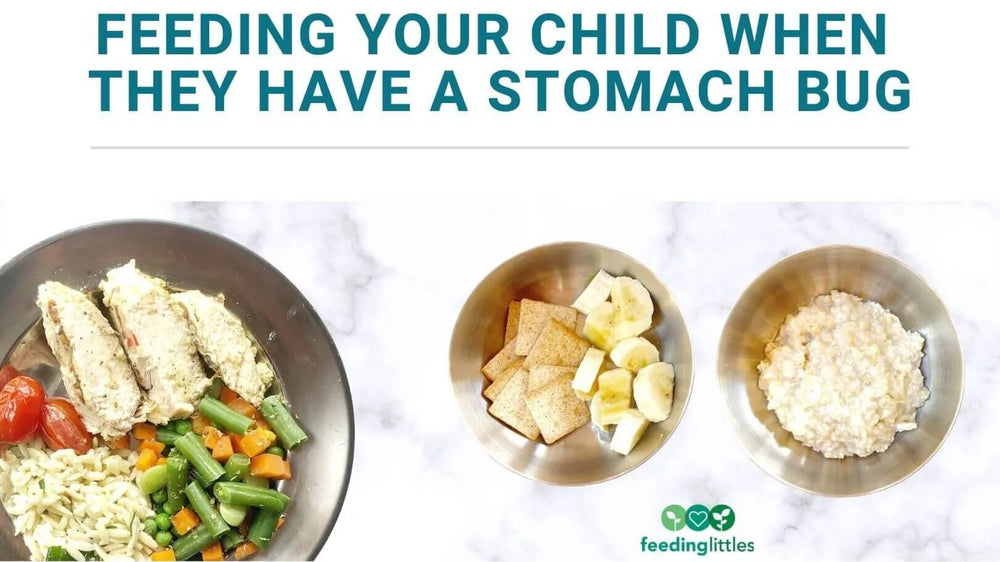
Stomach Bugs and GI Issues
Stomach bugs or acute gastroenteritis will almost certainly affect the amount and types of food your kiddo eats.
Babies: Just like with respiratory illnesses, hydration is most important when babies are sick with GI bugs. Dehydration is especially dangerous with stomach bugs because babies can quickly lose fluids from vomiting and diarrhea. Continue to offer regular breastfeeds and bottle feeds and watch for 5-6+ wet diapers per day. If your baby is continually vomiting or has profuse diarrhea and you’re worried about their hydration status, speak with your provider right away. Make sure your baby can tolerate breast milk or formula before offering bland foods like banana or crackers, then offer a regular diet if bland foods are tolerated.
Toddlers/Kids: Below are some simple guidelines to remember when our kids are vomiting or have diarrhea:
1) Start with small amounts of liquids.
2) If those are tolerated, move onto bland foods like toast, soup/broth, crackers, oatmeal, eggs or applesauce.
3) Once bland foods are tolerated, move onto a regular, varied diet – just avoid super heavy foods like fried or greasy options as they get better. The BRAT (banana, rice, applesauce, toast) diet is not recommended long-term, although your child might prefer those foods as they’re recovering from a tummy bug.
4) Juice is generally not recommended during stomach bugs because it contains a lot of fructose and sorbitol, which can actually worsen diarrhea. If juice is all your kiddo will drink, make sure to dilute it.
Sometimes water isn’t sufficient to rehydrate kids when they’re losing fluid quickly from profuse vomiting or diarrhea. Oral Rehydration Therapy, or ORT, means to drink solutions that are made with an appropriate amount of salt, sugar and fluid to help your child’s body absorb lost electrolytes appropriately. Many people are familiar with Pedialyte or sports drinks, and those can work for oral rehydration. Many parents like the brand Kinderlyte since it doesn’t contain artificial sweeteners or dyes but has the recommended ratio of electrolytes, potassium and zinc to dextrose (sugar).
By the way, sugar is essential in ORT drinks – it helps more quickly shuttle electrolytes through the bloodstream to rehydrate kids faster. Coconut water may be a good substitute if your kid likes the flavor, but keep in mind that it’s much lower in potassium than ORT and may not rehydrate as effectively. Some families make their own ORT at home using salt, sugar and water – talk to your doctor before exploring this route!
Hydration (Don't miss this part!):
During periods of illness, the number one nutritional concern is dehydration. Focus on fluids above all else. Babies under 12 months should still be consuming at least 20-24 ounces of breast milk or formula, and we want toddlers and older kids to drink lots of water to stay hydrated and get better. Remember that high fluid volume foods like fruit and soup count, too! Estimated fluid needs per the American Academy of Pediatrics are as follows:
- 1-3 years: 4 cups (32 ounces or ~1 L)
- 4-8 years: 5 cups (40 ounces or ~1.2 L)
- 9-13 years: 7-8 cups (56-64 ounces or ~1.7-1.9 L)
Instead of worrying about ounces, watch your child. Make sure they’re urinating regularly and don’t show signs of dehydration, including dry lips or mouth, fewer wet diapers or trips to the bathroom, loss of energy, less interest in playing, or a change in their skin color/tone.
To help your child drink more water, check out this post.
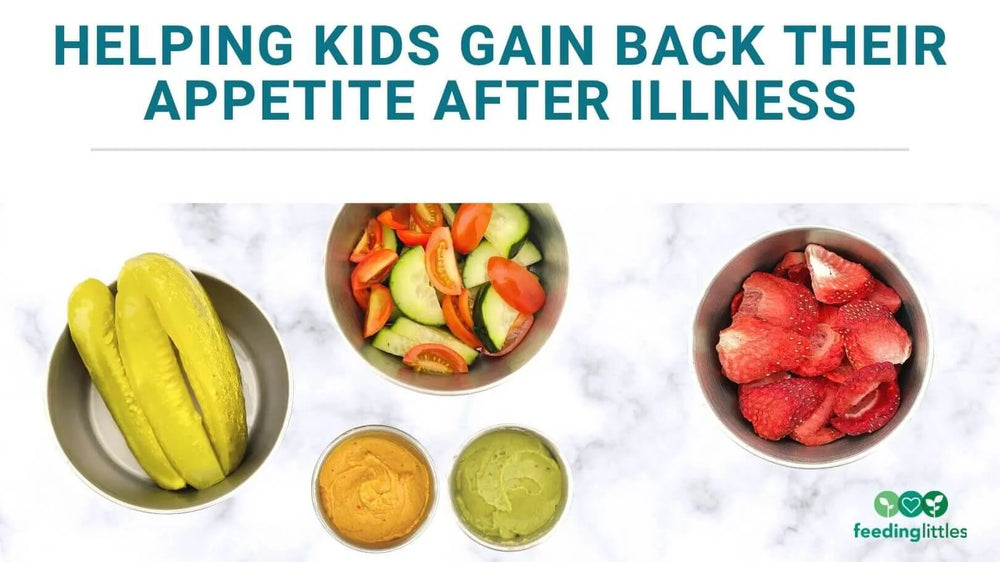
Appetite after Illness
Ever notice that it takes a while for your kiddo’s appetite to return after they have been sick? After an illness, your child’s taste buds may be dampened. Viruses can inhibit taste and smell function, and sometimes congestion prevents kids from smelling (and thus tasting) appropriately. You may experience this as an adult, too. Adding highly flavorful food to their regular meals can help “wake up” their tastebuds and get them back to eating like normal again!
One strategy Judy loves to use with her clients is to offer a highly flavorful, crunchy, sour or salty food once or twice a day to help “wake up” their taste buds. She has found that kids who have been sick sometimes seek out these flavors so they can taste again. Try foods like:
- Freeze-dried fruit (mango, strawberries, raspberries)
- Pickles
- Cucumber or tomato paired with a strongly flavored dip like hummus or guacamole
- Olives (remember to remove pits and quarter lengthwise for kiddos under 4 years old)
- Whole wheat baguette dipped in balsamic vinegar and olive oil
- Ground meat seasoned with cumin and garlic
- Cooking with flavorful spices like cinnamon, ginger and paprika
You can also try lemon, lime or spicy food (if your kiddo usually enjoys and tolerates it).
Don’t be surprised if your child’s appetite takes a while to return to normal when they have been sick. If they seem to be losing weight or not improving over time, work with your provider.

Vitamin C
Vitamin C is a critical nutrient in immune system function. No, eating vitamin C foods doesn't prevent all illness, but your child's immune system may be stronger if they get lots of vitamin C in their diet.
Oranges are not the only way to get your daily dose of C! Many fruits and veggies – yes, even potatoes – can fulfill a great percentage of your child’s daily needs. Below are some kid-favorite foods that are high in vitamin C:
- Strawberry – 21 mg
- Mango – 15 mg
- Kiwi – 42 mg
- Papaya – 22 mg
- Tomato – 6 mg
- Potato (cooked) – 3 mg
- Broccoli – 25 mg
- Cantaloupe – 15 mg
- Red bell pepper – 48 mg
Breast milk and formula are great sources of vitamin C, too! In fact, babies’ vitamin C needs are met by their milk alone.
According to the NIH, here are vitamin C needs based on age:
- 1-3 year-olds: 15 mg
- 4-8 year-olds: 25 mg
- 9-13 year-olds: 45 mg
Does vitamin C help with illness? We know that some people swear by heavy dosing of vitamin C supplements when they feel run down. While some studies have suggested that vitamin C may shorten the duration of illness, other research does not support this theory. Plus, giving your kiddo high vitamin C doses can cause diarrhea and stomach upset. The upper limit for vitamin C and kids is 400 mg for kids 3 and younger and 650 mg for kids 4-8. In general, unless your child has an extremely limited diet or malabsorption issues, they likely don’t need a vitamin C supplement. Vitamin C deficiency (scurvy) in industrialized countries is very rare. Talk to your provider if you’re concerned.
Interestingly, vitamin C also helps our bodies absorb iron, so pairing a high vitamin C food with high iron foods like meats, poultry, fish, lentils, beans and nut butters can help your child’s body absorb iron, a critical nutrient in childhood.
The bottom line? Make sure you’re offering vitamin C foods regularly to your child to help support the immune system and other physiologic functions, but loading them up on more vitamin C than their body needs won’t necessarily help prevent illness.
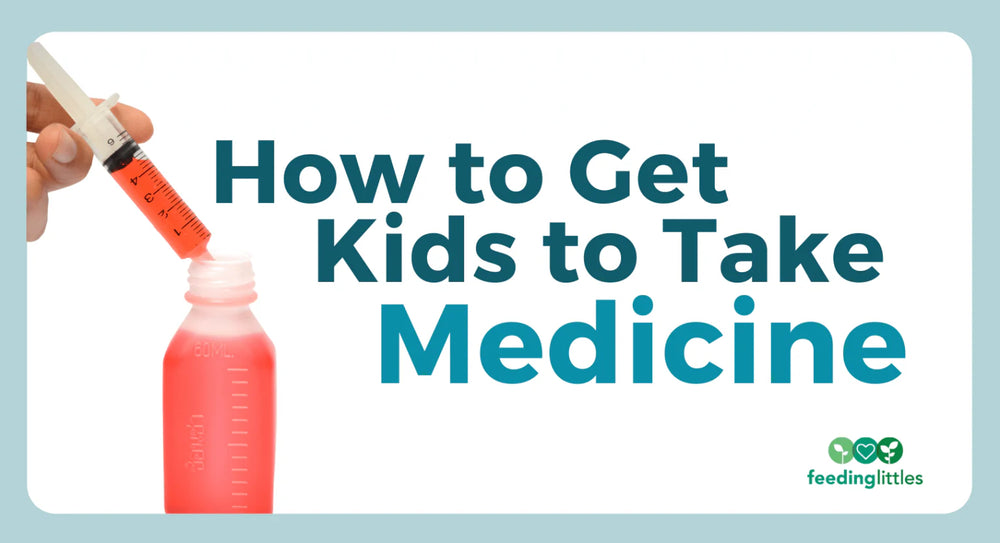
How can I get my kids to take medicine when they refuse it?
There’s nothing worse than a sick kid who would feel much better if they just took their dang medicine. If your kiddo refuses prescribed meds, here is an amazing blog post from physician Steve Silvestro, MD on various ways to make taking meds a little easier on everyone.
We also asked our Feeding Littles Clients Only Facebook Group for tips on giving medications to kids who refuse them. Of course, work with your provider when it comes to meds – these are simply ideas that might help if all else fails. Judy also recommends separating medicine from mealtime. Offer the medicine in a different room, bathroom or anyplace that’s not associated with mealtime.
- “We mix with chocolate pudding. And we’ve tried allllllll the other options. It was the only thing that worked.”
- “Add it to a smoothie or yogurt.” (Note: talk to your doctor to make sure this is OK, as some medications are not meant to be mixed with dairy foods.)
- “Ask for it in a chewable version of the medication.”
- “If your child doesn’t like the flavor, see if the pharmacy can make it in another flavor.”
- “We would challenge our son to a race… ‘Think you can swallow this before I count to 5?’ Then have a ‘chaser’ ready. He would always finish it before we counted all the way, then we would marvel at his speed.”
- “Put it into a fancy glass like a shot glass or mini tea cup.”
- “Chase it with a fruit popsicle, chocolate syrup or root beer.”
- “My 4 yr old had to take antibiotics about a month ago and she HATED it. Our pediatrician suggested a “chocolate syrup chaser”. I put a tiny squirt of it into the spoon and let her lick it (to get that chocolatey taste in her mouth before the medicine). Then I gave her the meds in the same spoon, then added another tiny squirt of the syrup to “chase” away the medicine taste afterwards. This was literally the ONLY thing that work with her.”
- “Mix it into a milkshake, but don’t freeze it – that might change the medication.”
- “Top the medicine cup with whipped cream or spray it into their mouth as a chaser.”
- “I split the dosage. I put a little at a time in OJ and we made a drinking game (who can chug the fastest). In five minutes he took the whole dosage amount.”
Once your child is four, they can try swallowing a pill instead of requiring a liquid or chewable. Read more about teaching your child how to swallow a pill here.
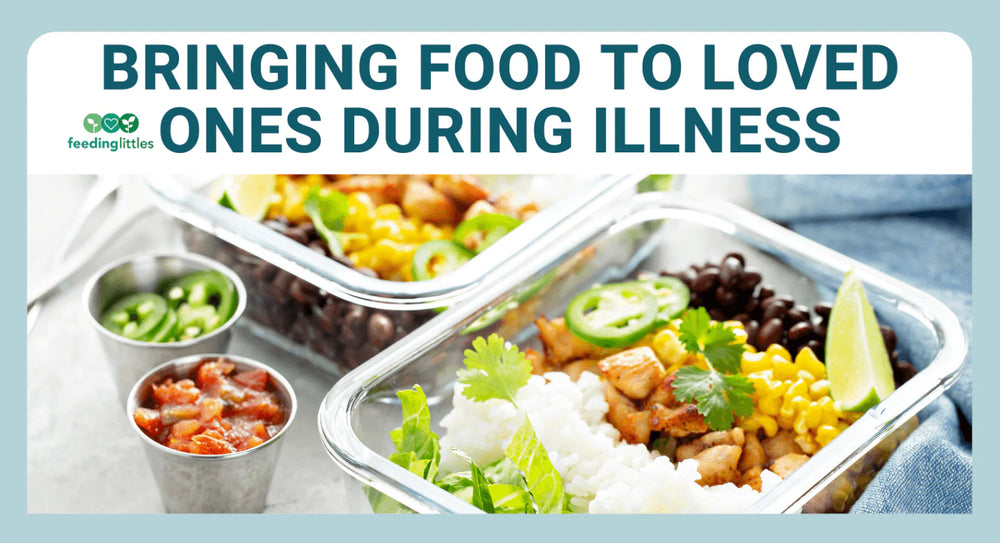
Bringing Food to Loved Ones During Illness
Finally, we wanted to share a resource for people who want to support families during illness or medical need. One of the best ways we can support and love on another family is by feeding them, especially during a stressful time. Check out this post for more inspiration.
We want to thank Dr. Alok Patel, board certified pediatrician at UCSF in San Francisco and Columbia in NYC, for his input and for sharing what pediatricians worry most about with feeding when it comes to illness.
